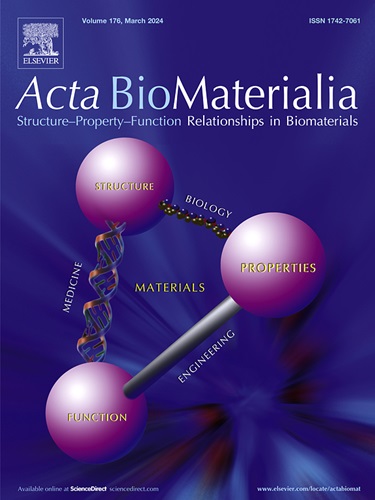DNA tetrahedron nanomedicine for enhanced antitumor and antimetastatic effect through the amplification of mitochondrial oxidative stress
IF 9.4
1区 医学
Q1 ENGINEERING, BIOMEDICAL
引用次数: 0
Abstract
Amplifying mitochondrial oxidative stress by elevating reactive oxygen species (ROS) and reducing glutathione (GSH) levels proved highly effective in eradicating tumor cells and inhibiting metastasis. How to significantly amplify mitochondrial oxidative stress remains a challenge due to the hypoxic microenvironment and high level of GSH in the mitochondria. Herein, we smartly fabricated a multifunctional DNA tetrahedron nanomedicine (tDNA-TPP-AuNCs-BPQDs) for intracellular enzyme activated fluorescence imaging and amplified mitochondrial oxidative stress. The apurinic/apyrimidinic site (AP site) on the cantilever of DNA tetrahedron (tDNA) could be rapidly cleaved by apurinic/apyrimidinic endonuclease 1 (APE1), allowing for in situ fluorescence imaging of APE1 with high sensitivity and specificity. Gold nanoclusters (AuNCs) could continuously convert intracellular H2O2 to O2 to alleviate the hypoxic conditions and adsorb intracellular GSH, thus the photodynamic therapy (PDT) effect of black phosphorus quantum dots (BPQDs) and AuNCs triggered a ∼10-fold and ∼3-fold increase in ROS generation compared to tDNA-TPP and tDNA-TPP-BPQDs, respectively. The elevated ROS and reduced GSH led to mitochondrial oxidative stress. In addition, the photothermal therapy (PTT) effect of the BPQDs and AuNCs further amplified the mitochondrial oxidative stress, which successfully induced immunogenic cell death (ICD) process and triggered a systemic antitumor immune response. The nanomedicine could render activation of fluorescence signal and anti-tumor therapeutic activity (34-fold higher than control) in tumor, thereby achieving effective tumor growth inhibition and antimetastatic effects.
Statement of significance
1. An effective mitochondrion targeting delivery system (tDNA-TPP-AuNCs-BPQDs) was developed for enhanced antitumor and antimetastatic effect through amplifying mitochondrial oxidative stress.
2. The multifunctional nanomedicine integrates tetrahedra DNA, Au NPs, TPP, and BP quantum dots to synergistically enhance cancer therapy effect through amplified mitochondrial oxidative stress. Additionally, an AP site segment was strategically incorporated into the tDNA structure for in situ fluorescence imaging of APE1 with high sensitivity and specificity in tumor cells.
3. The elevated ROS and reduced GSH amplify mitochondrial oxidative stress to induce ICD. The relieved hypoxic tumor microenvironment and induced ICD further stimulate a systemic antitumor immune response.

求助全文
约1分钟内获得全文
求助全文
来源期刊

Acta Biomaterialia
工程技术-材料科学:生物材料
CiteScore
16.80
自引率
3.10%
发文量
776
审稿时长
30 days
期刊介绍:
Acta Biomaterialia is a monthly peer-reviewed scientific journal published by Elsevier. The journal was established in January 2005. The editor-in-chief is W.R. Wagner (University of Pittsburgh). The journal covers research in biomaterials science, including the interrelationship of biomaterial structure and function from macroscale to nanoscale. Topical coverage includes biomedical and biocompatible materials.
 求助内容:
求助内容: 应助结果提醒方式:
应助结果提醒方式:


